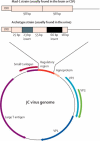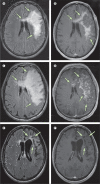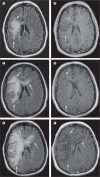Progressive multifocal leukoencephalopathy and other disorders caused by JC virus: clinical features and pathogenesis
- PMID: 20298966
- PMCID: PMC2880524
- DOI: 10.1016/S1474-4422(10)70040-5
Progressive multifocal leukoencephalopathy and other disorders caused by JC virus: clinical features and pathogenesis
Abstract
Progressive multifocal leukoencephalopathy (PML) is a rare but often fatal brain disease caused by reactivation of the polyomavirus JC. Knowledge of the characteristics of PML has substantially expanded since the introduction of combination antiretroviral therapy during the HIV epidemic and the development of immune reconstitution inflammatory syndrome (IRIS) in patients with PML. Recently, the monoclonal antibodies natalizumab, efalizumab, and rituximab--used for the treatment of multiple sclerosis, psoriasis, haematological malignancies, Crohn's disease, and rheumatic diseases--have been associated with PML. Additionally, the JC virus can also lead to novel neurological disorders such as JC virus granule cell neuronopathy and JC virus encephalopathy, and might also cause meningitis. The increasingly diverse populations at risk and the recent discovery of the presence of the JC virus in the grey matter invite us to reappraise the pathogenesis of this virus in the CNS.
2010 Elsevier Ltd. All rights reserved.
Figures





Comment in
-
Comment to: Progressive Multifocal Leukoencephalopathy and Other Disorders Caused by JC Virus: Clinical Features and Pathogenesis : C. D. Tan, I. J. Koralnik Lancet Neurol 2010;9:425-37.Clin Neuroradiol. 2010 Jun;20(2):141-2. doi: 10.1007/s00062-010-0011-z. Clin Neuroradiol. 2010. PMID: 20512302 No abstract available.
References
-
- Koralnik IJ. Progressive multifocal leukoencephalopathy revisited: Has the disease outgrown its name? Ann Neurol. 2006 Aug;60(2):162–73. - PubMed
-
- Eng PM, Turnbull BR, Cook SF, Davidson JE, Kurth T, Seeger JD. Characteristics and antecedents of progressive multifocal leukoencephalopathy in an insured population. Neurology. 2006 Sep 12;67(5):884–6. - PubMed
-
- Holman RC, Janssen RS, Buehler JW, Zelasky MT, Hooper WC. Epidemiology of progressive multifocal leukoencephalopathy in the United States: analysis of national mortality and AIDS surveillance data [see comments] Neurology. 1991;41(11):1733–6. - PubMed
-
- Koralnik IJ, Schellingerhout D, Frosch MP. Case records of the Massachusetts General Hospital. Weekly clinicopathological exercises. Case 14-2004. A 66-year-old man with progressive neurologic deficits. N Engl J Med. 2004 Apr 29;350(18):1882–93. - PubMed
-
- Molloy ES, Calabrese LH. Progressive multifocal leukoencephalopathy: a national estimate of frequency in systemic lupus erythematosus and other rheumatic diseases. Arthritis Rheum. 2009 Dec;60(12):3761–5. - PubMed
Publication types
MeSH terms
Grants and funding
LinkOut - more resources
Full Text Sources
Other Literature Sources
Molecular Biology Databases

